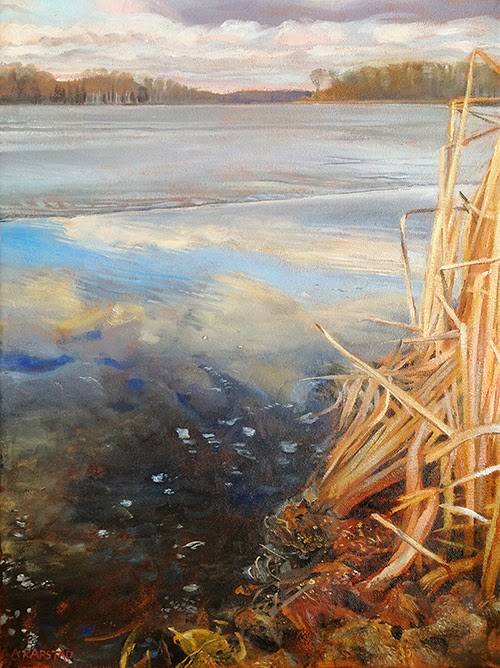Rideau Crossing (oil on canvas 12 x 16 in.)
Fred moved along the shore as I scrubbed on the burnt sienna underpainting, collecting a "recycling bag" of the kind of litter humans leave, as well as carefully gathering handfuls of the most shell-rich duckweed drift. This is the
"long Reach" of the Rideau Canal, between Merrickville and Manotick. Its level is drawn down a little for the winter, about 30 cm below summer levels, but now risen a little from meltwater. The ice along shore is shallowly flooded over by meltwater. We saw melted-down snowmobile tracks heading out from the boat launch towards a single early ice hut in mid-river.
"long Reach" of the Rideau Canal, between Merrickville and Manotick. Its level is drawn down a little for the winter, about 30 cm below summer levels, but now risen a little from meltwater. The ice along shore is shallowly flooded over by meltwater. We saw melted-down snowmobile tracks heading out from the boat launch towards a single early ice hut in mid-river.
There were some Bur-reed among the cattails, and strikingly, no rough dark spikes of Purple Loosestrife, which used to dominate Rideau shores like this, thanks to the diligent little Galerucella Beetles brought from Europe to control it. Fred noted one stand of tall Nettle, reduced to strong narrow stalks and terminal tufts, and Swamp Milkweed scattered in grey poddy clumps along the shore. Some boat-podded Common Milkweed stood about the field, leaning at odd angles, having somehow escaped the mowing.
The trees along the shore are mostly Ash, with some White Elm, and right near the launch a few big Eastern White Cedar. Most of these have been hacked into by Pileated Woodpecker. There is one Bur Oak sapling, corky and spreading branchlets from its base. Some of the Elm have succumbed to Dutch Elm Disease, but in the bark of the Ashes there are no tiny "D-shaped" exit holes which are the sign of Emerald Ash Borers. These devastating invaders are all through urban Ottawa now, and when they arrive here, this shore will be desolate.
Fred found a scattering of Canada Goose feathers, left by a predator, perhaps human. A Crow flew past as I gathered my brushes up and packed my paints. A Raven passed unseen overhead, commenting, "Clork, clork". As we headed back to the truck we noticed a Robin, and a few Starlings and Redwings hanging about in an Ash tree above a heavily fruited Buckthorn bush. These migrants seem to have been staying longer into the winter in recent years, perhaps due to the gradual spread of Buckthorn.
Now after the social distractions of the holidays, I've finally finished my "birthday painting", and Fred is going through the drift sample from the site. It proves to be a curious mixture of shells – a few of the juvenile Zebra Mussels that have radically changed the ecology of the river since 1990 by wiping out both the native Unionid Mussels and the filter-feeding European Faucet Snails that used to be super abundant in the Rideau. There are also no Viviparus Mystery Snails and no fingernail or pea clams. Now the big shells are mostly Bell-mouth Ramshorns (Helisoma campanulatum), and only a few Large Ramshorns (H. trivolvus). No high-spired Lymnaeid Pond snails at all! The medium sized snails are flat round Promenteus exacuosus, most of them eroded to white little disks. The little snails (only a few millimetres in size) are mostly round-spired Hydrobiids, and tiny flat Gyraulus, with a very few of the usually-common Valvata. He sifts, puffing and shaking the fluffy dried duckweed, then washes the results to further separate the shells from different classes of detritus. He's found only two land snails among the hundreds of aquatic shells, One spindle-shaped Cochlicopa and one tiny disk-shaped Nesovitrea.
Dear supporters and patrons of my art,
This 12 x 16 inch oil painting is available for $575 from Art Etc at the Art Gallery of Burlington.
For more information, contact Rhonda Bullock,
Art Sales and Rental Coordinator, (905) 632-7796 #301
Art Sales and Rental Coordinator, (905) 632-7796 #301
Sales of my paintings support our research and conservation work,
Aleta




Comments
Post a Comment
What do you think of this painting, and what do you know about the subject that I have painted?